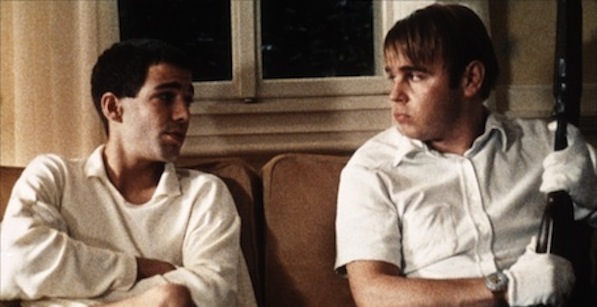With Michael Haneke‘s new film Amour (Love) freshly premiered and overwhelmingly embraced at Cannes, I thought it a fine occasion to revisit his earliest works. Re-watching Haneke’s first five features, The Seventh Continent (1989), Benny’s Video (1992), 71 Fragments of a Chronology of Chance (1994), The Castle (1997) and Funny Games (1997), the dominant impression left by the great precision in these works—whether in their narrative, dramatic or visual construction, even while depicting cataclysmic dysfunction in individuals, families or society at large—is that one is in the presence of a control freak without equal in the contemporary cinema.
Not everyone thralls to Haneke’s exacting approach, especially when they feel the jerk of his chain a bit too violently. It was 15 years ago that Haneke made his Cannes competition debut with the original Funny Games. Its infamous “kitchen” and “remote control” scenes elicited vehement boos and bewildered applause in equal measure. That film sought to deprogram viewers from their knee-jerk habits while watching action thrillers; it made them reflect on the underlying class and social assumptions that govern both the real world and the movie world. But Haneke’s mission of liberation is paradoxically one programmed on his own terms, with the audience led down a strictly delineated path to arrive at a state of abjection. Or, to put it in his own words, he intends to “rape the viewer into independence.”
[iframe width=”640″ height=”360″ src=”http://www.youtube.com/embed/ElgK45Z9dCk” frameborder=”0″ allowfullscreen]
That quote from a 2007 interview with The New York Times exposed the issues underlying Haneke’s relationship with his audience. Like a dictator, he works under the premise that he knows what’s best for his people. Perhaps it’s the same premise that leads to our willing submission to all the artists we embrace. But something in Haneke’s hyper-controlled filmmaking makes the equation feel unbalanced. Maybe it’s Haneke that could use a little liberating, and or a taste of his own medicine. So in the spirit of Peter and Paul in Funny Games, this video is abducting a few fragments of Haneke’s films, playing with and poking at them to see what makes them tick. There is no grand scheme or end result to these fragments, except to tear a hole into their painstaking construction, so that some fresh air might get in.
Instead of blood and guts exploding from Frank Giering’s midsection, we see some special effects paraphernalia: a safety pack on his belly to protect him from exploding gunpowder, and some impressive coordination between the explosion effects both in front of and behind him. What’s also impressive is his posture as he receives the blow. Most people would flinch, cower, or curl, but Giering stands erect, practically heroic; all the better for the particles to fly from his chest.
Notes:
The Castle (1997). When I mentioned this video essay to Daniel Kasman at MUBI, he suggested doing something with the many tracking shots of Ulrich Mühe walking in the snow. These shots are practically the only ones shot outdoors in a film that’s set within a series of confining interiors, but they end up feeling as claustrophobic. Put together it also becomes apparent how physically punishing these snowy scenes must have been for Mühe to shoot.
Funny Games (1997) This is an obvious riff on the “remote control” moment that follows the shot chosen here, but with the aim to dissect one of the film’s most disturbing moments (that’s also the most cheer-inducing for the audience). Instead of blood and guts exploding from Frank Giering’s midsection, we see some special effects paraphernalia: a safety pack on his belly to protect him from exploding gunpowder, and some impressive coordination between the explosion effects both in front of and behind him. What’s also impressive is his posture as he receives the blow. Most people would flinch, cower, or curl, but Giering stands erect, practically heroic; all the better for the particles to fly from his chest.
The Seventh Continent (1989): How telling that in the film’s most cataclysmic sequence of a family’s feature length journey of steady self-destruction, every shot is precisely patterned, moving from one series of related images and objects to the next. Haneke himself can’t succumb to chaos without a blueprint – one that also provides the components for this one minute fugue of mayhem.
71 Fragments of a Chronology of Chance (1994): This segment is fairly self-explanatory: Each clip is played at roughly 1000x speed, all of them centered at the midpoint, so the variety of their length is evident. The film is a confounding puzzle of causality vs. non-causality and remains such within this layout.
Benny’s Video (1992): I find “The Girl” (she doesn’t even have a name!) played by Ingrid Stassner to be the most tragic and affecting of all of Haneke’s characters. Maybe because she’s the most like us (or how we like to think of ourselves) when watching a Haneke movie: an innocent bystander unexpectedly implicated in the diabolical designs of someone wielding a camera. Let her fate be a cautionary tale for all of us: To see Michael Haneke films (much less “enjoy” one), we must be prepared to see through them.
Kevin B. Lee is Editor in Chief of IndieWire’s PressPlay Video Blog, Video Essayist for Fandor Keyframe, and contributor to Roger Ebert.com. Follow him on Twitter.




